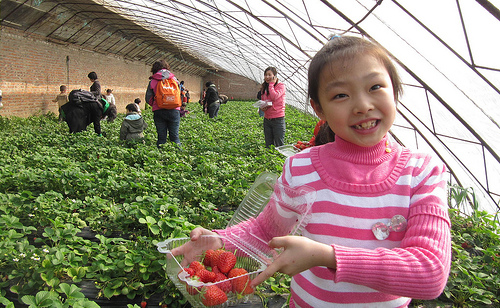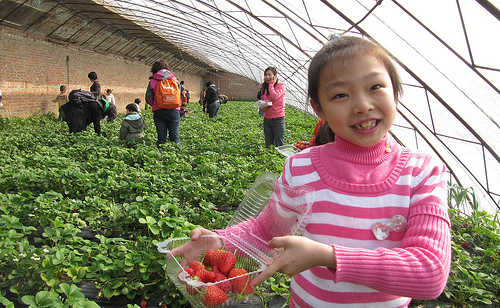 A young girl shows off the organic strawberries she picked on a farm in China. Photo: Ivan WalshWhen you follow the global eco-politics of food, it’s hard not to get depressed about China.
A young girl shows off the organic strawberries she picked on a farm in China. Photo: Ivan WalshWhen you follow the global eco-politics of food, it’s hard not to get depressed about China.
The macro story — which I told in a column four years ago — goes like this: Flush with cash from selling stuff to the U.S. and Europe, China’s vast industrial base just keeps expanding, swallowing up (and fouling up) farmland at an alarming rate. As the nation’s arable land shrinks and its population’s appetite for meat grows, the country has to import heaping amounts of food. In turn, biodiverse savanna and even rainforest in places like Brazil succumbs to the plow to produce soybeans to make up China’s shortfall.
Meanwhile, looking west to the highly destructive U.S. model, China is rapidly transitioning from backyard hog farming to gigantic hog factories. And to keep the hogs in feed, they’re importing titanic amounts of U.S. corn — by far our most destructive crop. The globe’s most populous nation is also snapping up prime farmland in Africa to ensure its food security and considering using some of its vast currency reserves to buy a massive industrial ag player like fertilizer giant Potash of Saskatchewan or pork titan Smithfield.
Then there are the country’s seemingly endless food-safety scandals.
And yet, China has one of the globe’s proudest and most diverse food cultures — and, given that lots of people have been growing food there for a long time, its farming traditions clearly have much to teach us.
Just as our own sustainable food revolution didn’t take place until we had nearly driven all of our small farms into penury, China is evidently feeling the stirrings of a backlash against the brutalization of farming and the industrialization of food.
I first heard about the trend in Fuchsia Dunlop’s luminous 2008 New Yorker profile of the restaurant Hangzhou, whose chef/owner Dai Jianjun “has never heard of Chez Panisse or Stone Barns,” but is nevertheless “engaged in a similar mission: to guarantee the integrity of his food supplies while shoring up a dying culinary and agricultural heritage.” Dunlop describes the culinary context of Jianjun’s radical experiment:
As recently as the early nineties, many Chinese lived on a diet of fresh seasonal produce bought from street markets. Supermarkets, refrigerators, and processed foods were rare. Since then, urban sprawl has encroached on arable fields; street markets and small restaurants have been swept away as cities are redeveloped; and Western fast-food chains have opened branches all over the country. Meanwhile, firms such as Carrefour and Tesco have persuaded the middle classes to shop in supermarkets, and processed foods have become widely available.
In today’s Washington Post, William Wan identifies a fledgling movement of “young urban professionals” who are “giving up high-paying salaries in the city and applying their business and internet savvy to once-abandoned [farm] properties. They are trying to teach customers concepts such as eating local and sustainability.” The young farmers Wan talks to are struggling — both to explain their moves to skeptical family members, and to grow food without chemicals (when everyone else is dousing crops with pesticides, bugs love to feast on unsprayed plants).
We should remember that globalization works in multiple ways, not just the corporate-dominated one. Just as U.S. transnationals have forged ties with China’s bureaucrats to open factories there, U.S. organic farmers and food activists should reach out to our Chinese peers. In the task of creating food systems that make sense, we are all in this together.



